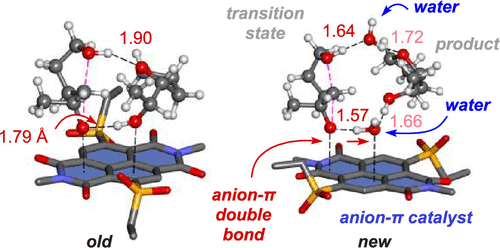- Gutiérrez López, M. Á.; Tan, M.-L.; Frontera, A.; Matile, S. “The Origin of Anion−π Autocatalysis” JACS Au 2023, 3, 1039-1051

The autocatalysis of epoxide-opening ether cyclizations on the aromatic surface of anion−π catalysts stands out as a leading example of emergent properties expected from the integration of unorthodox interactions into catalysis. A working hypothesis was proposed early on, but the mechanism of anion−π autocatalysis has never been elucidated. Here, we show that anion−π autocatalysis is almost independent of peripheral crowding in substrate and product. Inaccessible asymmetric anion−π autocatalysis and sometimes erratic reproducibility further support that the origin of anion−π autocatalysis is more complex than originally assumed. The apparent long-distance communication without physical contact calls for the inclusion of water between substrate and product on the catalytic aromatic surface. Efficient anion−π autocatalysis around equimolar amounts but poor activity in dry solvents and with excess water indicate that this inclusion of water requires high precision. Computational models suggest that two water molecules transmit dual substrate activation by the product and serve as proton shuttles along antiparallel but decoupled hydrogen-bonded chains to delocalize and stabilize evolving charge density in the transition state by “anion−π double bonds”. This new transition-state model of anion−π autocatalysis provides a plausible mechanism that explains experimental results and brings anion−π catalysis to an unprecedented level of sophistication.
open archive unige:168323 • pdf ![]()
